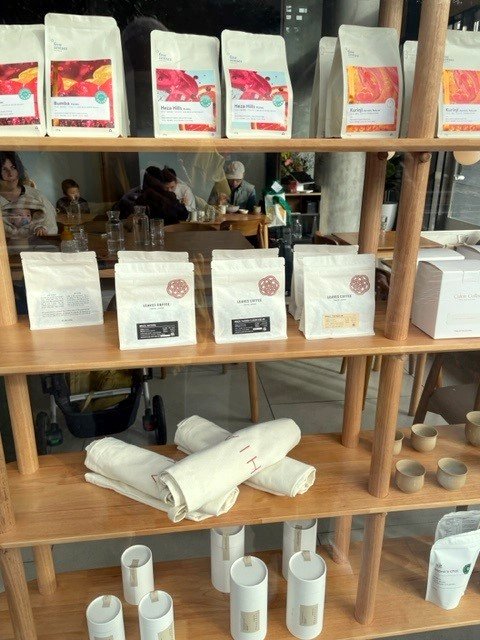Chiaki – Introduction
Whenever our friend Pat Nourse raves about a new food outlet, in this case Chiaki in Collingwood, we always take the recommendation seriously and try to get there as soon as possible.
When we saw that the partners in the Chiaki project are Alicia Feng aka Alicia Meow and Mo Zhou we knew the coffee would be good considering their association with Calere coffee in Gertrude St and the ubiquitous Kantaro Okado who is responsible for the delightful 279 in Victoria St where we love to have breakfast of Musubi (those tasty triangular rice snacks), Le Bajo Milk Bar which is also just off Victoria St (and where they serve the best egg sandwiches), our go-to place for ice cream Hareruya Pantry in Carlton opposite Lincoln Square and Leonie Upstairs which serves a dizzying array of sake upstairs from Hareruya.
Chiaki – The Food
The name of their new venture is Chiaki and it is on the corner of Wellington St and Peel St in Collingwood. In their words it provides “Modern Ochazuke + Specialty Coffee & Tea”. It is open for breakfast and lunch with only walk-ins at lunch time (you put your name on the list outside and wait until you are invited inside).
You can see the place where you add your name to the list hanging beside the door of the Peel St entrance.

What is Ochazuke you may well ask? It is a common Japanese dish of perfectly cooked rice topped with varying items and then some form of liquid (often tea but it varies) poured over the rice.
Below is a copy of the top half of the Chiaki menu for the day we had lunch – and the chance of enjoying bonito sashimi was too good to pass up so we ordered the Katsuo sashimi Set menu which came with a lot of side dishes that complemented the central rice dish perfectly.

There were other lunch options available as can be seen on the rest of the page below.

The main rice bowl with the sashimi bonito is show below:

Greens side dish.

And a beautifully cooked, perfect onsen egg

And there was also a plate of pickles to add contrast to the textures and flavours.

The meal was perfect and we thought it represented great value for money as there was so much textural and flavour variation.
In fact, we were so impressed that we returned two days later for breakfast for a slightly less expansive, but still delicious, breakfast version.
Chiaki – The Tea and Coffee
The other reason for making this a regular place to visit is the exciting range of coffee and tea options. We were delighted to peruse the range of coffee beans available in the window as shown in the photo below. You won’t be able to read the packets of coffee or the tea on the bottom shelf but the next photo will give you an example of the type of coffee they have available.

First to the coffees. They have a great selection of beans from many parts of the world which have been roasted in either Japan or Australia. For example, the packet shown immediately below was roasted in Japan by Leaves Coffee in Tokyo. It was grown in Brazil by the Deterra company who grow a large range of different bean varieties including Laurina which is also known as Bourbon Pointu and was almost extinct when some beans were taken from the last remaining crop on Reunion Island to Brazil.

And another thing we should mention is that many of the coffees on display are naturally processed (as opposed to washed processed). There are two reasons why we prefer natural process coffee. the firs tis that the washed process is very wasteful of water especially in parts of Africa, and in particular Ethiopia. The second is that the natural process sees little or no water used with other techniques such as carbonic maceration used to remove the fruit from the two beans inside.
You can read more about some of these issues in our article about coffee called “Coffee – A Fascinating Story“.
You can see the cylinders of tea on the bottom shelf and they favour the Yunnan area where the very famous bo lai or pu-erh tea is found. We have two favourite areas for tea in China. One is Yunnan and the other is the area inland from Hangzhou where the green Dragon Well tea is cultivated.
While the teas grown in these two areas are essentially the same, the teas in Yunnan tend to be aged as is the case with pu-ehr tea which is normally sold as compressed discs of aged tea which might be 20 years old. In the Dragon Well area the tea is sold fresh and green. It is picked and then undergoes a quick heat treatment and is then packaged and sold. We once spent a fascinating day in the Dragon Well area with the leading grower seeing the picking and treatment processes as well as tasting the current vintage.
We will look forward to exploring the teas from Chiaki in the future.
You can read more about Chiaki on their Web site which you will find here.






















